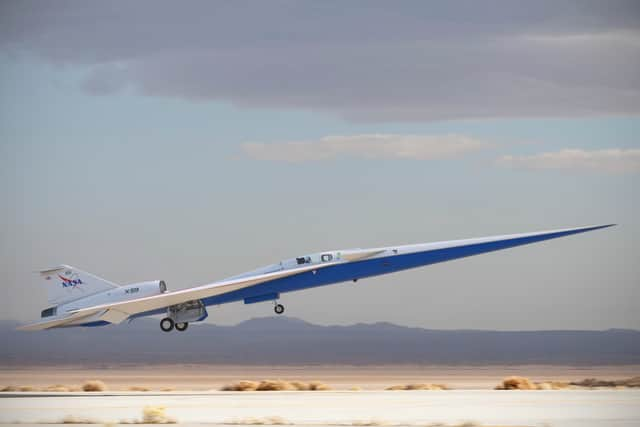Nasa announces plans for supersonic passenger jet that could fly from London to New York in 90 minutes
and live on Freeview channel 276
Nasa has announced plans to develop a supersonic passenger plane - faster than the speed of sound.
The use of such a jet could see commercial passengers fly from London to New York in 90 minutes.
Advertisement
Hide AdAdvertisement
Hide AdNasa's Quesst mission was launched in 2016 with an aim to design an aircraft with technology that reduces the loudness of a sonic boom.
The project has led to the creation of X-59, a Concorde-like research jet designed by defence contractor Lockheed Martin that can cruise at 937mph at an altitude of 55,000ft without creating an unacceptable noise level.


By comparison, today’s larger airliners cruise at roughly 600 mph, or about 80% of the speed of sound.
Test flights are hoped to be run over US cities in 2024, to gather data on locals' response to the sound, with the hope it could inform changes to aviation rules.
Advertisement
Hide AdAdvertisement
Hide AdCompanies including Boeing and Rolls-Royce have been contracted to come up with a potential roadmap for making such trips a reality - including design concepts for supersonic passenger planes.
Lori Ozoroski, project manager for Nasa’s Commercial Supersonic Technology Project said: "We conducted similar concept studies over a decade ago at Mach 1.6-1.8, and those resulting roadmaps helped guide Nasa research efforts since, including those leading to the X-59.
"These new studies will both refresh those looks at technology roadmaps and identify additional research needs for a broader high-speed range."
Mary Jo Long-Davis, manager of Nasa's hypersonic technology project, said: "The design concepts and tech roadmaps are really important to have in our hands when the companies are finished.
Advertisement
Hide AdAdvertisement
Hide Ad"We are also conscious of the need to account for safety, efficiency, economic, and societal considerations.
"It's important to innovate responsibly so we return benefits to travellers and do no harm to the environment."
The announcement comes just weeks after X-59 was moved from its construction site to the so-called flight line, the space between the hangar and runway at a Lockheed Martin facility in California.
The firm has started a series of ground tests ahead of a potential trial flight later this year after being given a £187.5m contract to build the plane,
Peter Coen, Nasa's Quesst mission integration manager, has said his team are "ready to write a new chapter in the history of supersonic flight".
Comment Guidelines
National World encourages reader discussion on our stories. User feedback, insights and back-and-forth exchanges add a rich layer of context to reporting. Please review our Community Guidelines before commenting.
